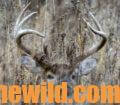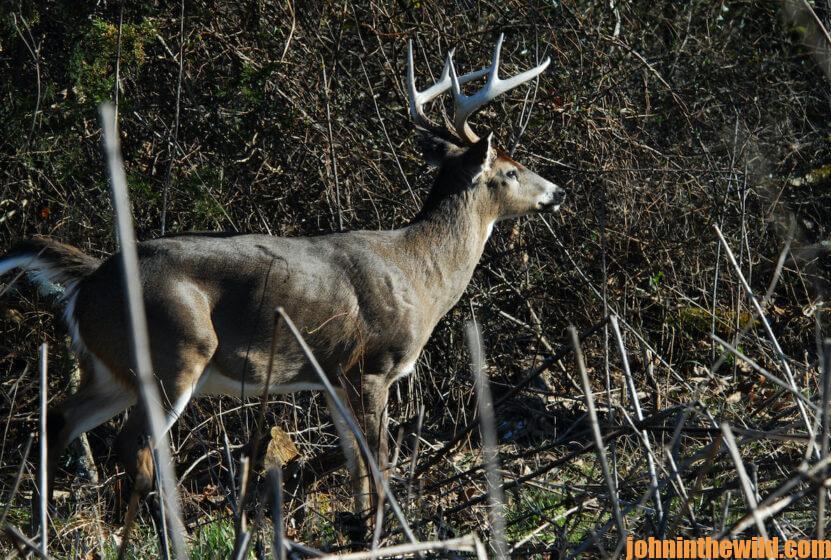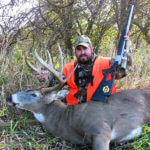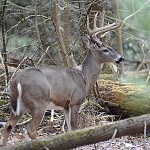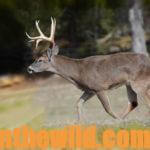Editor’s Note: Deer sign sometimes lies to hunters. If you could trust all deer sign, you’d bag a buck near every deer sign you find in the woods. But how do you know when deer sign lies, and when it tells the truth? How can you tell if the deer has made the sign during the day or the night, today or three weeks ago? To hunt deer successfully, you must not only find deer sign – you must interpret correctly what that sign tells you.
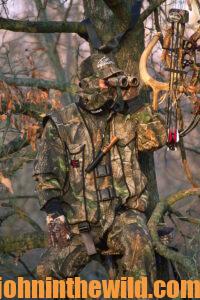 Deer don’t read magazine articles or books on deer hunting and often don’t do what we think they should. They just do what deer do, and often that means acting unpredictably. If you keep your mind closed when you hunt deer, the sign you read may not tell you the correct or the complete story.
Deer don’t read magazine articles or books on deer hunting and often don’t do what we think they should. They just do what deer do, and often that means acting unpredictably. If you keep your mind closed when you hunt deer, the sign you read may not tell you the correct or the complete story.
A few years ago, a bowhunter had scouted a region before deer season and discovered the perfect place to take a buck. Some bushes where deer had rubbed their antlers grew along a trail that led from the south end of an overgrown agricultural field. Deer bedded down at the field, which had an almost impenetrable wall of briars and thick brush along its outer edge. The trail from the field meandered along the edge of a creek and led to a group of white oak acorn trees where the deer could feed. A week before bow season began, the hunter had set-up a tree stand about 150 yards from this trail on a little hill. He could view the trail with his binoculars, but the deer would have a hard time seeing him. The hunter went to the stand the day before he would hunt to make sure he had a favorable wind. Well before daylight, he climbed into his stand. As the sun started to come up, he kept his eyes glued to the trail that ran through the acorn trees where he thought the deer bedded. During that time, his eyes followed a 4-pointer, two 6-pointers, a spike and a really-nice buck. He also saw about 10 does come down that trail from first light until about 9:00 am. He had found a hot spot for deer.
The hunter had so much confidence in this place, he’d already concocted a plan for opening morning, even before the hunt. He planned to let the spike, the 4-point and the 6-point bucks pass his stand and wait to shoot the 8-pointer. He felt he had a foolproof hunting strategy.
He had:
- found the sign that indicated deer frequently used this trail;
- set-up well away from the trail before hunting season, so as not to spook the deer; and
- seen deer before on the trail.
Now he only had to put up his tree stand the afternoon before opening morning and climb in the stand before daylight. He’d probably take a buck and return to camp before 9:00 am. He felt as confident as he ever had about his ability to take a buck with his bow.
The bowhunter could hardly sleep the night before the opening day of bow season. When his alarm clock finally rang at 3:30 am, he jumped out of bed, gathered his equipment and headed for his stand. He stood in his tree stand just as the sky had enough light to see. He already had his mechanical release attached to his bowstring, and his arrow nocked. He knew any minute he’d have to draw and shoot to take a buck.
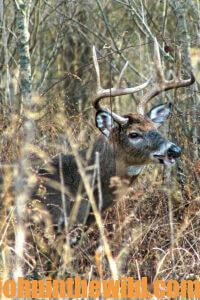 However, by 9:00 am, he hadn’t seen a deer. At 11:00 am, he still hadn’t spotted a deer. He left his stand and went back to camp to eat lunch. In comparing notes with a friend, he discovered that his pal also had found a deer hot spot. “I saw a bunch of deer in this feeding area I found last week,” his buddy told him. “But when I went to hunt before daylight, I spooked the deer. I set-up my tree stand anyway, thinking they might return to this spot later in the morning. I did see one deer, however, I never got off a shot. I’m going back there this afternoon.” After lunch, both hunters returned to their stands, but neither of them saw deer. That night, they promised to get to their stand sites earlier than usual the following morning. They hoped that if they paid the price of getting up earlier, Lady Luck might smile on them.
However, by 9:00 am, he hadn’t seen a deer. At 11:00 am, he still hadn’t spotted a deer. He left his stand and went back to camp to eat lunch. In comparing notes with a friend, he discovered that his pal also had found a deer hot spot. “I saw a bunch of deer in this feeding area I found last week,” his buddy told him. “But when I went to hunt before daylight, I spooked the deer. I set-up my tree stand anyway, thinking they might return to this spot later in the morning. I did see one deer, however, I never got off a shot. I’m going back there this afternoon.” After lunch, both hunters returned to their stands, but neither of them saw deer. That night, they promised to get to their stand sites earlier than usual the following morning. They hoped that if they paid the price of getting up earlier, Lady Luck might smile on them.
Although the bowhunter arrived at his tree stand the next morning before daylight, by 9:30 am, he still hadn’t spotted any of the bucks he’d watched walk down the trail before bow season opened. But then off in the distance, he heard some deer moving down the trail. A tree had blown across the trail about 30-yards from his stand, and the deer had made a new trail around the blown-down tree. As the sounds came closer, the deer sounded as though they moved slowly and cautiously on the other side of the blown-down tree where the hunter couldn’t see them. All his muscles tensed as he took the slack out of his string and his mechanical release, preparing to draw his bow. He expected one of the bucks he’d seen before the season to appear in just a few seconds.
When he saw movement at the end of the tree, he looked for the spot where he planned to take the shot. Finally something came around the end of the blown-down tree. However, instead of the 8-point the hunter expected to see or even one of the 6-point bucks, he saw his hunting buddy. He let his friend walk within 15 yards of his stand and then said, “Hey, Bubba, what are you doing on the deer trail I’m hunting over?” The 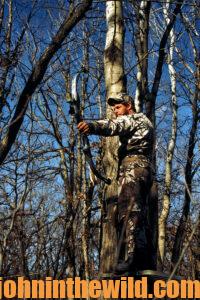 other hunter almost jumped out of his skin. He had assumed no one else had gone to that section of the woods. He looked up and asked, “What are you doing up in that tree?” The hunter replied that he’d hoped to take a buck moving down the trail that his friend had just polluted with his human odor.
other hunter almost jumped out of his skin. He had assumed no one else had gone to that section of the woods. He looked up and asked, “What are you doing up in that tree?” The hunter replied that he’d hoped to take a buck moving down the trail that his friend had just polluted with his human odor.
Then the hunter realized why the deer he’d seen before the season hadn’t come down the trail as he’d expected. The other hunter told him he originally had hunted about 200-yards up the trail. And on this morning, like the previous morning, he’d spooked the deer feeding around the oaks he’d discovered earlier before the season. Although his pal hadn’t seen any deer, he’d decided to follow the trail from the feeding site and learn where the deer went. Then he’d have a place to hunt that afternoon. He hadn’t realized they both were hunting the same section of land and surely didn’t know the two of them hunted the same trail for the same deer. Apparently, his pal spooked the bucks he’d seen earlier in the season, when he went to his stand each day.
Both men learned several valuable lessons from that hunt.
- Hunt sign most hunters won’t find. If you locate deer sign easily, another deer hunter probably will identify that same sign.
- Remember most deer hunters in public-hunting areas who can read deer sign will see the obvious sign. Although the sign doesn’t lie, it probably won’t lead you to deer.
- Realize that other hunters will spook deer that leave easy-to-find sign in public places or even on private lands where several people hunt. Most hunters don’t go quietly to their stands and pay no attention to wind direction and its effect on deer. They’ll spook more deer than they’ll take. And what’s worse, they’ll spook the deer you hope to bag. Generally the most-obvious deer sign will show you the least-effective spots to put your tree stands early in the season. If you don’t spook the deer making that sign, often someone else will spook them for you.
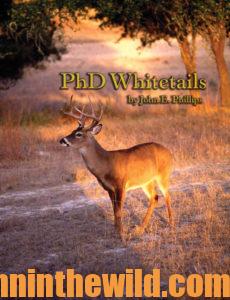 To learn more about hunting for deer, check out John E. Phillips’ deer-hunting book, “PhD Whitetails: How to Hunt and Take the Smartest Deer on Any Property,” available in Kindle and print at http://amzn.to/WIEUoo and Audible at https://www.audible.com/pd/PhD-Whitetails-Audiobook/B08VYMWS6J. You may have to copy and paste this link into your browser. (When you click on this book, notice on the left where Amazon says you can read 10% of the book for free). On the right side of the page and below the offer for a free Audible trial, you can click on Buy the Audible book. To see more of John’s deer-hunting books, visit http://www.amazon.com/author/johnephillips. John and Denise Phillips’ new book, “The Recipes You Can’t Live Without,” that’s full of delicious, time-tested recipes for cooking wild game and fish and also ideas for breakfasts at your hunting club just was published in print this past week. Go to https://www.amazon.com/dp/B09MYTMSMH?ref_=pe_3052080_397514860 to learn more.
To learn more about hunting for deer, check out John E. Phillips’ deer-hunting book, “PhD Whitetails: How to Hunt and Take the Smartest Deer on Any Property,” available in Kindle and print at http://amzn.to/WIEUoo and Audible at https://www.audible.com/pd/PhD-Whitetails-Audiobook/B08VYMWS6J. You may have to copy and paste this link into your browser. (When you click on this book, notice on the left where Amazon says you can read 10% of the book for free). On the right side of the page and below the offer for a free Audible trial, you can click on Buy the Audible book. To see more of John’s deer-hunting books, visit http://www.amazon.com/author/johnephillips. John and Denise Phillips’ new book, “The Recipes You Can’t Live Without,” that’s full of delicious, time-tested recipes for cooking wild game and fish and also ideas for breakfasts at your hunting club just was published in print this past week. Go to https://www.amazon.com/dp/B09MYTMSMH?ref_=pe_3052080_397514860 to learn more.
Tomorrow: Find Deer Sign Least Likely to Lie


